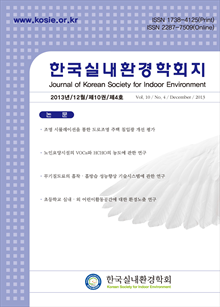간행물
한국실내환경학회지 KCI 등재후보 Journal of Korean Society for Indoor Environment

- 발행기관 한국실내환경학회
- 자료유형 학술지
- 간기 계간
- ISSN 1738-4125 (Print)2287-7509 (Online)
- 수록기간 2004 ~ 2013
- 주제분류 공학 > 환경공학 공학 분류의 다른 간행물
- 십진분류KDC 547DDC 697
권호리스트/논문검색
Vol. 7 No. 2 (2010년 6월) 5건
1.
2010.06
구독 인증기관 무료, 개인회원 유료
Bioaerosols, airborne particles of biological origin, are omnipresent in the common surroundings of humans. In antimicrobial filter system, as particles or organic materials are deposited on the filter surface, the bacteria come into contact with the antimicrobial material less, and thus they can easily grow on particles or organic materials. We selected a carbon fiber ionizer which generated air ions as antimicrobial agent. Antimicrobial effect of carbon fiber ionizer on the outlet air and condensate water was tested using application of carbon fiber ionizer in a small-scale commercial air conditioner. In conclusion, the application of carbon fiber ionizer in the air conditioner showed more increasing antimicrobial efficiency.
4,300원
2.
2010.06
구독 인증기관 무료, 개인회원 유료
This study was performed to investigate the concentration of indoor aldehydes in children’s facilities. The samples were collected from various children's facilities (40 playrooms, 42 day-care centers, 44 kindergartens, and 42 indoor playgrounds) in summer (Jul~Sep, 2007), winter (Jan~Feb, 2008) and spring (Mar~Apr, 2008). The ratio of Indoor and outdoor (I/O) of aldehydes exceeds 1.0 and the formaldehyde levels in each child-care facilities were significantly different. We evaluated the lifetime cancer and non-cancer risk of young children due to indoor aldehyde exposure. We estimated the lifetime excess cancer risks (ECRs) of formaldehyde, acetaldehyde and the hazard quotients (HQs) of non-carcinogens (benzaldehyde and formaldehyde). Formaldehyde was evaluated for both carcinogenic and non-carcinogenic risk. The average ECRs of formaldehyde for young children were 1×10-4~1×10-5 level in all facilities. HQs of four non-carcinogens did not exceed 1.0 for all subjects in all facilities.
4,300원
3.
2010.06
구독 인증기관 무료, 개인회원 유료
The purpose of this study is to investigate the potential exposure of chemicals from the working environment of nail shops and determine health-related symptoms from the nail shop workers by self-reporting questionnaire. A total of 54 nail shop workers from 15 different locations were asked to conduct a survey concerning their working environment. VOCs (including toluene and nine other substances) and aldehyde(including formaldehyde and four other substances) detected. We studied on the relationship between the environmental concentration of chemical substances and the self-reported symptoms of nail shop workers. There was a significant relationship between the neck pain and substances such as 2- propanol, benzene, toluene, n-buthylacetate, ethylbenzene, and xylene (p<0.01). Furthermore, symptoms in the nose irritation, neck irritation and recurrent coughs had significant relationship with benzene (p<0.05), whereas, toluene showed significant relationship with neck irritation and symptoms such as coughs and fatigue (p<0.05).
4,300원
4.
2010.06
구독 인증기관 무료, 개인회원 유료
In order to capture the indoor CO2 gas from public indoor spaces, a commercial zeolite(4A) was modified with alkali metals useful for adsorption. The prepared sorbents showed somewhat improved adsorption capacity. A few isotherm models were reviewed to characterize the adsorption mechanism of test sorbents. Sips model was found the most appropriate for low level indoor CO2 adsorption, but revealed a significant error in low pressure regimes and required numerical analysis for quantitative evaluation. Thus, a parameter(qm) in the equation was empirically recorrelated with a operation temperature. As a result, the final model equation including a simple linear function presented less errors for evaluation of the potential capacity of adsorption.
4,600원
5.
2010.06
구독 인증기관 무료, 개인회원 유료
This study investigated the indoor air concentrations and the harmful effects on health by hazardous pollutants in the normal classrooms and special classrooms of 132 elementary, middle, and high schools located in 13 sites in Chungnam from February 2006 to June 2007. The results obtained from this investigation are as follows. As the results of the survey on the indoor air quality, volatile organic compounds were higher in normal classrooms(251.67㎍/m3) than special classrooms (181.59㎍/m3), and formaldehyde was significantly higher in special classrooms (34.22㎍/m3) than normal classrooms (24.61㎍/m3). With regards to the differences of pollutant distribution among elementary, middle, and high schools, volatile organic compounds were the highest in elementary schools (210.79㎍/m3) followed by middle schools (207.79㎍/m3) and high schools (195.96㎍/ m3), and formaldehyde was the highest in high schools (36.03㎍/m3) followed by elementary schools (29.84㎍/ m3) and middle schools (29.16㎍/m3). With regards to the mean concentration of pollutants by school building age, VOCs were the highest in less than 1 year old classrooms (410.93㎍/m3), followed by less than 3 years old classrooms (156.52㎍/m3) and less than 2 years old classrooms (120.18㎍/m3). Formaldehyde was also investigated to be significantly higher in less than 1 year old classrooms (41.37㎍/m3) than 2 or 3 years old classrooms (31.50㎍/m3, 22.21㎍/m3, respectively).
4,000원

